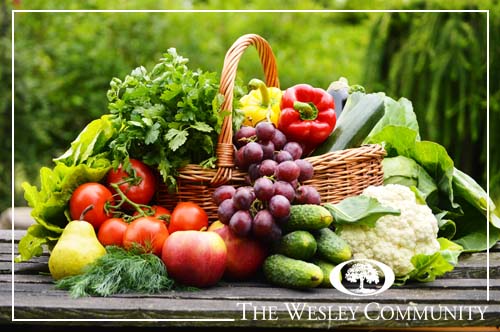Hydration is a key component of a healthy lifestyle. Learn how food can increase fluid intake and make summer safer for a senior loved one.

As we head into what are often referred to as the dog days of summer, it’s important to take time to review options for staying hydrated. To avoid heat-related illness, from mild symptoms such as fatigue to full-blown heat stroke, it’s essential to know how to protect yourself in the sun and humidity.
If you are the caregiver for a senior loved one, it’s especially important to learn more about hydration and the signs of a heat-related illness. Older adults are often at increased risk for heat illnesses because of chronic health conditions and medication side effects.
As concerns about the spread of COVID-19 linger, helping an older family member stay hydrated may prevent a trip to the emergency room. That’s important during these uncertain times.
Fortunately, drinking water isn’t the only way to pump up fluids in the body. Food choices can also play a role, so know which ones to consume and which to avoid.
Foods That Hydrate
- Melons, berries, and stone fruits
On a hot summer day, fruit can be a refreshing treat. Cantaloupe, watermelon, peaches, plums, blueberries, and strawberries all have a high water content. They are also low in fat and rich in vitamin C and fiber. Keep a bowl of sliced-up fruit in your fridge to nibble on and add to smoothies.
- Cucumbers
At 96% water, cucumber is one of the most hydrating food choices you can make. They are great in sandwiches and salads, and a nutritious addition to a cold gazpacho soup. A senior gardener might enjoy growing their own cucumbers in a container garden on a porch or patio.
- Leafy greens
Loaded with crucial vitamins and nutrients, mixed greens are also packed with water. Whether you like romaine, arugula, spinach, or kale, each is a core ingredient for salads. They can also be added to sandwiches, smoothies, and soups.
- Celery
Celery is a much-underrated vegetable. Low in fat and calories, it is also high in water. This crunchy veggie is a good source of vitamin K, potassium, and fiber. You can slice it and top with a little peanut butter for extra protein.
- Bell peppers
Like celery, bell peppers have a water content of 90%. They are also rich in potassium, fiber, folate, iron, and vitamins A and C. You can enjoy them raw, roast them on the grill, eat them in soup, or add a few slices to your favorite stir-fry.
- Tomatoes
Tomatoes are another hydrating food to consume when the mercury rises. They contain 94% water, which is the equivalent of about a half cup of water. Tomatoes also provide the body with a healthy dose of fiber, antioxidants, and other essential nutrients.
By contrast, foods with caffeine can be dehydrating and should be limited. Fried foods, sugary treats, and salty snacks are others to avoid on hot days.
9 Signs of Heat-Related Illnesses
Despite your best efforts to stay hydrated, you or a loved one might experience heat-related problems. Early intervention is the key for preventing small symptoms from becoming a serious health crisis.
Here are a few of the signs you or a loved one might need to see a doctor for a heat-related health problem:
- Dizziness
- Confusion
- Sluggishness
- Fatigue
- Muscle cramps
- Diarrhea
- Vomiting
- Rapid pulse
- Profuse sweating
Depending on the severity of the condition, you should consult your family doctor or visit the emergency room. Heat stroke, if untreated, can be fatal.
Healthy Dining at The Wesley Community
Whether in our campus café or dining room, well-balanced meals are a part of the daily menus at The Wesley. Good nutrition is vital for preventing dehydration, as well as helping residents maintain core strength. Call (518) 587-3600 to learn more!

